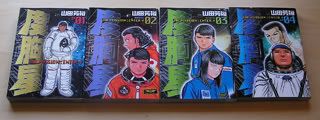
Dokyoboshi (度胸星)
by Yoshihiro Yamada (山田芳裕)
Published in Young Sunday (Shogakukan)
4 volumes (2000-2001)
Volume 1 Amazon.jp
Volume 2 Amazon.jp
Volume 3 Amazon.jp
Volume 4 Amazon.jp
Victim of a mysterious, controversial cancellation, Dokyoboshi (Star of Courage) was a short-lived sci-fi manga from the mid-late period of Yoshihiro Yamada's career (so far). By that point, Yamada was primarily known for his long-running track and field manga Decathlon, also from Young Sunday, though in his early career he had worked with Kodansha. Upon completing four volumes worth of material, and at a point that was clearly still in the early stages of the story, the manga ended abruptly and unsatisfactorily. Being that Yamada was a relatively famous author for Young Sunday (Decathlon ran to 23 volumes), this caused quite a bit of controversy among readers and on the internet. An official explanation was never made, but it seems clear from the circumstances of the story, and the fact that since this point Yamada has not worked with Shogakukan again, that it was cancelled by the magazine due to a shift in publishing strategy. Over five years after its untimely demise, the manga is today probably known more over the details of its ending than the actual content. It is out of print and I had to buy my copies used.
As for the actual manga, it has a curious mix of stereotypical and interesting elements. An obvious point of reference is its more famous contemporary Planetes. Like Planetes, it features "down-to-earth" depictions of astronauts in training and the hard slog to being one of the chosen few for a historic space expedition. However, unlike Planetes frame of the mundane (trash collectors) in a futuristic "hard" sci-fi setting, Dokyoboshi incorporates clearly fanciful elements such as a four-dimensional tesseract that serves as the trigger to carry the story forward.
The main character Dokyo (Courage) comes from the strong and plain, honest and good archetype factory: perfectly boring. Likewise, his companions come in the "sassy, smartmouth showoff guy" and "quiet, mysterious, withdrawn girl" flavors. Throughout the four volumes, their story consists entirely of their trials to be selected for a space mission. If you've read or watched other sci-fi astronaut-in-training series such as Planetes or Twin Spica, you'll recognize everything they're put through: the physical preliminary tests, the isolation booth test with some manual task to be done while various emergencies are simulated, the outdoor survival test. Really, nothing involving this portion of the story is remarkable or outstanding in any way. What is interesting is the other half of the story, and the reason these plain vanilla characters exist in the first place. On Mars, a mysterious 4-D object (instantly recognizable as a simple cube tesseract, if you've ever seen the diagrams) has appeared and is wrecking a manned exploration's craft and killing its crew. Though the use of the very simple generic tesseract isn't necessarily very creative, the completely obtuse and unpredictable ways it acts are ceaselessly fascinating. It is to investigate the mysterious end of communication from the Mars crew that Dokyo and his cohorts are training to be astronauts. For most of the manga the tesseract itself is unexplained to the reader, until a very hasty explanation is made just before the ending (no doubt Yamada hastening to at least give some sort of closure before he was canned). The final scene is of Dokyo and his companions, now official astronauts, taking off from Earth toward Mars. There is no resolution of the tesseract story.
Though he had already been a mangaka for over a decade by this point, Dokyoboshi still feels like the work of a man establishing his style, especially when compared to the much more rounded and elegant Hyougemono (which I'm sure I will write about at some point) that he is currently drawing. While his art is relatively realistic and not in a cutesy "otaku" style, there is a cartoony, rubbery feel to his expressions that lends itself well to comedy. I can't count how many gaping mouths there are in this series. Between the stilted nature of his composition and the hit-and-miss nature of his characters and settings, it's easy to find Yamada an endearing author with plenty of room to grow, and based on his output following Dokyoboshi, he has improved quite a bit.
5 comments:
People have been waiting for something like this for ages. Thank you!
Being very intrigued by situations than transcend conventional 'reality', I'm bound to have a look at it sooner or later. Shame it was cancelled though, his killer tesseract sounds like a great abstract beginning to his plot.
Have you ever read Decathlon? The art is surprisingly crude in the early parts of the series, but I think it best utlizes Yamada's unique (to say the least...) graphic skills. It helps that the subject matter is sports, which naturally features a lot of action, and it's amazing the way he captures the athletes as the pole vault, throw javelins, leap over hurdles etc.
I have heard elsewhere that the deformities of his style actually work to his favor in Decathlon. Having really bizarre/intense/kinetic depictions of action usually helps make up for a lack of realistic detail, so I can see how it would look good. But still, 23 volumes is a lot to sit through. Maybe if I luck out, I can find scans of it...
In a similar vein, his baseball manga Giant (which from what I recall was about 10+ volumes) also utilized his drawing style well, although I'd have to say that overall Decathlon was the more entertaining read.
Thanks for blogging this. I was trying to find out what happened to Yamada-san. The story is so promising it is such a waste to let it go. I think of it in the same strain as 2001 A Space Odyssey. Hope to hear from Yamada-san and hope he is doing well!
Post a Comment